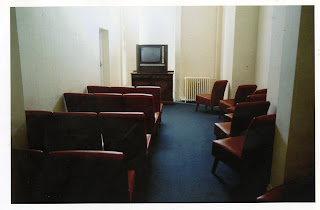Candida Hoefer
I photograph in public and semi-public spaces that date from various epochs. These are spaces available to everyone. They are places where you can meet and communicate, where you can share or receive knowledge, where you can relax and recover.
— Candida Höfer
Candida Höfer’s photographs reveal her interest in documenting collections of like things, she has created a systematic visual study of details within public spaces such as zoos, the interiors of office buildings, theaters, museums, and library reading rooms. There is a very distinct style in the straightforward and detached way in which she photographs that creates clinical, documentary style images.
No people feature in Höfer’s images instead the focus is on repeated forms within public spaces such as furniture, lighting fixtures, ceiling or floor tiles, to name a few creating patterns in the images as well as a sense of orderliness.
I greatly appreciate the visual aesthetic’s in the orderliness in the images that helps to create almost geometric patterns however I do not think that the clubs will be so easy to conform to one pattern. Some appear quite cluttered, especially in terms of wall space usage, yet on the other hand the excentric patterns in the carpets of many of the clubs I have visited would be a strong repetition to tie the images of the different clubs together. I don’t know if I want to do that though. It could work.
Also: http://www.icaphila.org/exhibitions/past/hofer.php
Academy of Medicine New York, 2001
Bahnhof Stadelhofen Zurich, 1991
Bibliothek Reiner Speck Cologne III, 2000
Bibliothek Walther Konig Cologne, 1998
F.Hoffmann-La Roche AG Basel i, 2002
Institut fur Versicherungsrecht der Universitat zu Koln I, 1989
Kunsthal Rotterdam I, 2000
Museen an der Augustinergrasse Basel III, 2002
Museum van Hedendaagse Kunst Ghent II, 1995
TV Lounge Scarborough, 1980
Cap San Diego Hamburg I, 2000
Die Deutschen Werkstatten Hellerau I, 2000
Museum fur Volkerkunde Dresden IV, 2000
“Members Only” investigates visually interior spaces that define themselves as clubs, mostly membership clubs. In Australia Clubs appeared to be institutions of great significance within the social landscape. Through exploring the homogeny and heterogeny in the clubs and the space’s where “like” comes together and “unlike” stays apart. It can be seen that the clubs manifest the accomplishment of a unified “taste” a harmony, a bringing together of certain personal elements. So whilst the clubs promote inclusion of those with shared interests and values, they equally promote the exclusion of those who do not conform.
The images are taken in various locations around the world includeding: Australia, China, the U.S., Spain, the Ukraine and England. This reinforces the homogeneity of the clubs as it is not immediately obvious from which country the clubs reside.
When I first found this I did not think my project held much weight after this as it is a much deeper exploration of the clubs then what I was doing. This has changed now as whilst Reinhardt’s images explore the spaces within the clubs to give a wider view of the club it’s interests and values, I aim to have more intimate studies of fewer clubs to give a more in depth study of them to try to understand its members.
Lynne Cohen
With an interest in the artificial and the everyday, focusing on the psychological, sociological and political aspects of her subjects Lynne Cohen photographs interior spaces, including laboratories, health spas, waiting rooms and classrooms, all devoid of people. Primarily being concerned with the way things appear and function in our lives. The disorientation her photographs provoke is largely the result of the specific yet mysterious nature of the places she photographs with their odd symmetries.
The disjointedness of Cohen’s images coupled with their stillness given them an unsettling feel. The unpopulated interiors suggesting activities that have already happened or might yet happen.
Cohen’s work is a cross between documentary photography and contemporary art, bringing together the ordinary and dream-like. The work has a very strong visual formal visual style. Every image is rigorously framed with the distance pretty much the same every time.






























